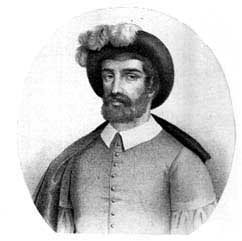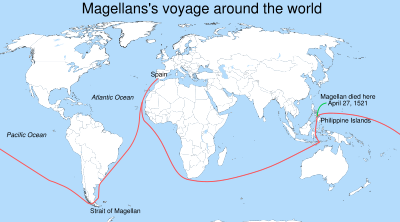Juan Sebastián Elcano
2007 Schools Wikipedia Selection. Related subjects: Geographers and explorers
Juan Sebastián Elcano ( Getaria, Guipuscoa, Spain, 1476 – Pacific Ocean, August 4, 1526) was a Basque explorer. He commanded back home the first successful expedition to circumnavigate the globe in 1522.
An adventurer, he fought under orders of Gonzalo Fernández de Córdoba in Italy and, in 1509, he joined the expedition organised by Cardinal Cisneros against Algiers. Later, he settled himself in Seville and became a merchant ship captain.
After violating Spanish law by surrendering a ship of his to Genoan bankers in repayment of a debt, he sought a pardon from the Spanish King Charles I, by signing on, as a subordinate officer, to Ferdinand Magellan's expedition to open a tras-Pacific route to the Spice Islands. Spared from execution by Magellan after taking part in a failed mutiny in Patagonia, Elcano was made captain of Concepción, one of five vessels. Elcano went on to take command of the fleet when Magellan was killed in the battle of Mactan, the Philippines, on April 27, 1521. Only three ships of the original fleet survived by then, but there were insufficient hands to man them, so Elcano set the Concepción on fire and continued voyage with the Trinidad and the Victoria.
After arriving to the Molucca islands November 8, 1521, and loading the ships with spices, he divided the fleet: the Trinidad was to sail back through the Pacific ocean, while the Victoria, captained by Elcano himself, would risk the passage of the Indian ocean, a Portuguese controlled area.
On March 18, 1522, Elcano discovered Île Amsterdam in the southern Indian Ocean (now Southern Ocean), but did not name the island.
On July, 1522, the Victoria, without enough water or other necessary supplies, arrived to the Cape Verde islands, a Portuguese base in the Atlantic coast of Africa. Elcano lied to the Portuguese authorities by telling them he was sailing from the Spanish territories in America. By the time his fabrication had been discovered, the Victoria had departed Cabo Verde sailing towards the Caribbean, and them back, with favourable winds, towards Cadiz.
On September 6, 1522, Elcano sailed into Sanlúcar de Barrameda, Spain, aboard the Victoria, after a 78.000 km trip around the world, along with 17 other European survivors of the 265 man expedition, and 4 (survivors out of 13) Tidorese Asians aboard. The profits resulting from the spices they carried made them rich. The king conceded him a coat of arms picturing a globe with the motto: Primus circumdedisti me (in Latin, "You went around me first"). In fact, it was a Southeast Asian native who was a servant of Magellan, who became the first man to circumnavigate the world when the fleet arrived to his home country.
In 1525, Elcano was a member of the Loaísa Expedition. He was appointed along with García Jofre de Loaísa as sea captains, who commanded 7 ships and sent to claim the East Indies for Spanish king Charles I. Both Elcano and Loaísa died of malnutrition in the Pacific Ocean while attempting a second circumnavigation of the world.
European survivors of the the expedition
| Name | Rating |
|---|---|
| Juan Sebastian Elcano, from Guetaria | Master |
| Francisco Albo, from Axio | Pilot |
| Miguel de Rodas | Pilot |
| Juan de Acurio, from Bermeo | Pilot |
| Antonio Lombardo (Pigafetta), from Vicenza | Supernumerary |
| Martín de Judicibus, from Genoa | Chief Steward |
| Hernándo de Bustamante, from Alcántara | Mariner |
| Nicholas the Greek, from Naples | Mariner |
| Miguel Sánchez, from Rhodes | Mariner |
| Antonio Hernández Colmenero, from Huelva | Mariner |
| Francisco Rodrigues, Portuguese from Seville | Mariner |
| Juan Rodríguez, from Huelva | Mariner |
| Diego Carmena | Mariner |
| Hans of Aachen | Gunner |
| Juan de Arratia, from Bilbao | Able Seaman |
| Vasco Gomez Gallego, from Bayona | Able Seaman |
| Juan de Santandrés, from Cueto | Apprentice Seaman |
| Juan de Zubileta, from Baracaldo | Page |

